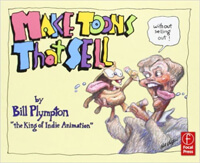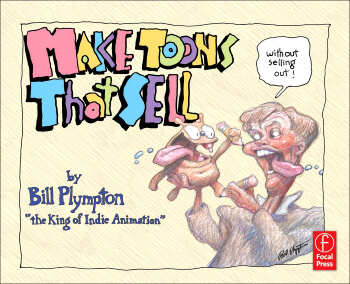Make Toons That Sell (Without Selling Out) – Book Review
Last year saw the release of indie animation veteran Bill Plympton’s book “Independently Animated”, one of the most entertaining and well put-together animation autobiographies out there (you can read our review of it here). While its focus was on the life and career of the man himself, in its closing chapters Mr. Plympton offered up some small nuggets of advice for aspiring filmmakers who might wish to follow a similar path. While these were welcome tidbits that certainly sent this reviewer on an exciting journey of self-producing/marketing one’s own films, they also yielded a fair few follow-up questions. Boiled down to what he refers to in his touring masterclasses as “Plympton’s Dogma”, the three fundamental rules of successful short filmmaking in animation are to keep things low budget, under five minutes long and, ideally, funny.
Of course, anybody who is part of a filmmaking community will be aware that most people have their own definitions of ‘success’. Some directors strive solely for awards, some for fame and wealth, some for both combined – though hopefully in any instance they hope for a film that represents their intent and artistic vision to come out of it. Such is the nature of commissioned filmmaking that this seemingly most important component is rarely an easy ride, and the only way to truly sidestep the meddling hands of investors is to be entirely in control of your own film.
Which leads us to Bill Plympton’s own definition of success: To do what you want and love what you do, while making a decent living out of it, whenever possible. This outlook lays the foundation for his new book “Make Toons That Sell (Without Selling Out)”, an outlook not very far away from that of an increasing number of auteur animators who are embracing the changing climate of this industry. Despite the title potentially setting off alarm bells, the book has no ‘instant-fame’ or ‘get-rich-quick’ pretensions, in fact the main thing that sells it as honest and grounded is his candour as to how much of a financial struggle living by his MO continues to be. Plympton’s personality is allowed to shine through the text, establishing early on that this is not a book for those who wish to be validated by the masses. While he himself is tremendously well-respected, he makes no claims of being a giant of industry, and as such all the advice given within the book is tempered with self-aware humility and frankness about his own shortcomings and creative misfires over the years.
Said advice spans the entire production process of a film, predominantly citing his own work and experience as examples with several other practitioners (including Don Hertzfeld, Pat Smith and Plymptoons producer Desiree Stavracos) weighing in. The portions of the book which will be of most use largely depends on which rung of animated filmmaking the reader feels they occupy. Perhaps the most crucial is the attention paid to the importance of well thought-out story development, a vital ingredient of any film and one that animators tend to let slide. Various options for raising funds are presented, with some valuable guidance for budgeting, production management and casting. In many respects the text lends itself to autobiography, such as in the latter instance where Plympton attributes his current fondness for films without dialogue to the complicated legwork of hiring and direction voiceover actors. As such this serves not only as a handy reference manual, but also a companion piece to “Independently Animated”, extending and elaborating on previously referenced themes and stories.
The portion of the book that deals with animation itself is the only segment that steers close to redundancy – there are, after all, countless essential texts on the craft that any animator will already have on their bookshelves. What makes Plympton’s take on it engaging reading is how he applies the fundamentals of competent animation – anatomy, design, perspective, timing, sound – to his own style. To Plympton fans it is a fascinating look into his process; to those being introduced to him through the text itself, it serves as a notable example of how these fundamentals are beneficial to all manner of artistic directions and design styles. If skimming, one might assume that the agenda with the book is to create an army of Plympton clones; in actuality it makes a strong case for the importance of finding your own voice, much as he himself was able to.
To the recent graduate or independent who has just finished their film and wants it out in the world, the penultimate two chapters covering the logistics of sales and self-distribution are absolutely essential. Given that the author himself readily admits the subject matter of his films frequently puts potential distributors off, the importance of persistence, self-belief and casting a wide net is made very clear. Again anecdotally referencing his own successes and failures in these regards, the perks and pitfalls of approaching festivals, distribution deals, agencies and networks are presented to the reader in a way that still leaves them with a great deal of their own decision making to do, but some valuable food for thought to chew on while they do so.
With a body of work that spans six independent features, roughly forty short films and a consistent stream of commercial work (spanning bumpers, adverts, music videos and his most recent “Simpsons” guest spot) it’s impossible to deny that Plympton is one of the animation industry’s truest self-made men. An outlet such as this book to impart his warts-and-all outlook on what he refers to as the Second Golden Age of Animation (a definition that, with each passing day, seems to apply less to studios and more to fellow independents taking the reins) is something all of us who feel our audience might be out there can benefit from.
Items mentioned in this article:



